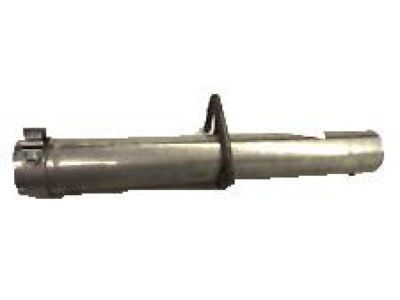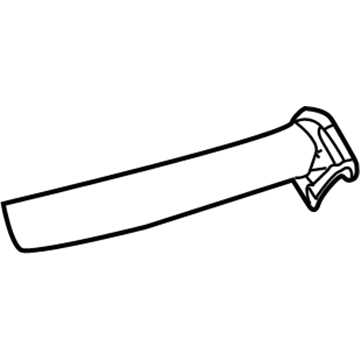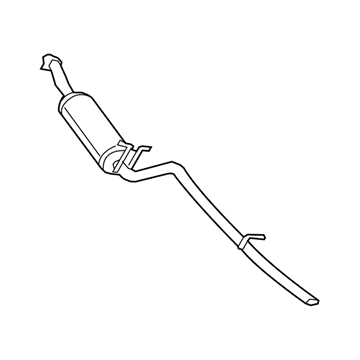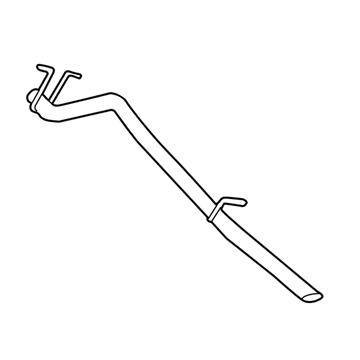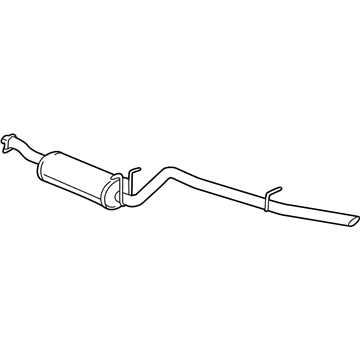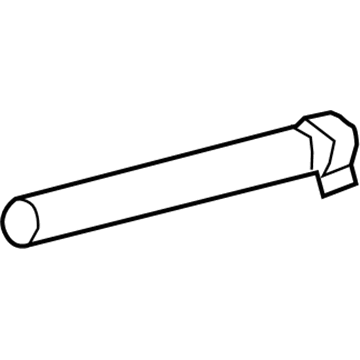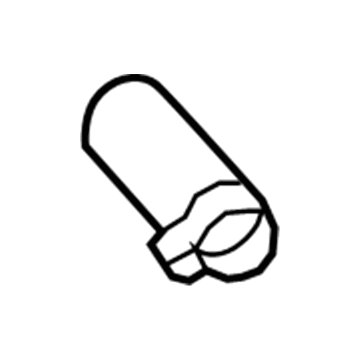FordParts
My Garage
My Account
Cart
OEM 2004 Ford F-150 Heritage Exhaust Pipe
Exhaust Tail Pipe- Select Vehicle by Model
- Select Vehicle by VIN
Select Vehicle by Model
orMake
Model
Year
Select Vehicle by VIN
For the most accurate results, select vehicle by your VIN (Vehicle Identification Number).
14 Exhaust Pipes found

2004 Ford F-150 Heritage Intermediate Pipe, Front Part Number: 6L3Z-5A212-J
$88.93 MSRP: $123.02You Save: $34.09 (28%)Ships in 1-2 Business DaysProduct Specifications- Other Name: Pipe - Exhaust Front; Exhaust Pipe; Direct-Fit Exhaust; Exhaust System Kit; Tail Pipe; Extension Pipe; Intermed Pipe
- Position: Front
- Base No.: 5A212
- Item Weight: 9.80 Pounds
- Condition: New
- Fitment Type: Direct Replacement
- SKU: 6L3Z-5A212-J
- Warranty: This genuine part is guaranteed by Ford's factory warranty.
2004 Ford F-150 Heritage Intermediate Pipe, Front Part Number: F85Z-5A212-BB
$67.71 MSRP: $92.14You Save: $24.43 (27%)Product Specifications- Other Name: Pipe - Exhaust Front; Exhaust Pipe; Direct-Fit Exhaust; Exhaust System Kit; Intermed Pipe
- Position: Front
- Base No.: 5A212
- Item Weight: 6.30 Pounds
- Condition: New
- Fitment Type: Direct Replacement
- SKU: F85Z-5A212-BB
- Warranty: This genuine part is guaranteed by Ford's factory warranty.
2004 Ford F-150 Heritage Muffler W/Tpipe, Rear Part Number: 4L3Z-5230-A
$398.90 MSRP: $547.29You Save: $148.39 (28%)Product Specifications- Other Name: Muffler And Pipe Assembly - Rear; Exhaust Muffler; Direct-Fit Exhaust; Exhaust System Kit; Exhaust Pipe; Muffler
- Position: Rear
- Replaces: 6L3Z-5230-DA, 6L3Z-5230-HA, 8L3Z-5230-B, 5L3Z-5230-MA, 4L3Z-5230-BB, 6L3Z-5230-FA, 8L3Z-5230-D, 5L3Z-5230-BA
- Base No.: 5230
- Item Weight: 48.60 Pounds
- Item Dimensions: 98.9 x 50.4 x 20.8 inches
- Condition: New
- Fitment Type: Direct Replacement
- SKU: 4L3Z-5230-A
- Warranty: This genuine part is guaranteed by Ford's factory warranty.

2004 Ford F-150 Heritage Muffler W/Tpipe, Front Part Number: 4L3Z-5230-B
$514.16 MSRP: $676.12You Save: $161.96 (24%)Product Specifications- Other Name: Muffler And Pipe Assembly - Rear; Exhaust Muffler; Direct-Fit Exhaust; Exhaust System Kit; Exhaust Pipe; Muffler
- Position: Front
- Replaces: 4L3Z-5230-AB, 6L3Z-5230-GA, 8L3Z-5230-A, 5L3Z-5230-LA, 8L3Z-5230-C, 6L3Z-5230-CA
- Base No.: 5230
- Item Weight: 49.10 Pounds
- Item Dimensions: 94.4 x 19.1 x 13.9 inches
- Condition: New
- Fitment Type: Direct Replacement
- SKU: 4L3Z-5230-B
- Warranty: This genuine part is guaranteed by Ford's factory warranty.

2004 Ford F-150 Heritage Tail Pipe Extension Part Number: 7L3Z-5255-AB
Product Specifications- Other Name: Pipe - Exhaust; Exhaust Tail Pipe; Exhaust Tip; Extension
- Replaces: 6L3Z-5255-AA
- Base No.: 5202
- Item Weight: 10.90 Pounds
- Item Dimensions: 8.0 x 17.7 x 13.5 inches
- Condition: New
- Fitment Type: Direct Replacement
- SKU: 7L3Z-5255-AB
- Warranty: This genuine part is guaranteed by Ford's factory warranty.
- Product Specifications
- Other Name: Pipe - Exhaust Front; Exhaust Pipe; Direct-Fit Exhaust; Exhaust System Kit; Intermed Pipe; Pipe - Exhaust - Front
- Position: Front
- Base No.: 5A212
- Item Weight: 2.20 Pounds
- Condition: New
- Fitment Type: Direct Replacement
- SKU: XL3Z-5A212-CA
- Warranty: This genuine part is guaranteed by Ford's factory warranty.
- Product Specifications
- Other Name: Muffler And Pipe Assembly; Exhaust Muffler; Direct-Fit Exhaust; Exhaust System Kit; Exhaust Pipe; Muffler
- Position: Rear
- Replaces: 1L3Z-5230-BA, 1L3Z-5230-DA, YL3Z-5230-AA
- Item Weight: 21.00 Pounds
- Condition: New
- Fitment Type: Direct Replacement
- SKU: XL3Z-5230-BA
- Warranty: This genuine part is guaranteed by Ford's factory warranty.
- Product Specifications
- Other Name: Pipe - Exhaust Front; Exhaust Pipe; Intermed Pipe
- Position: Front
- Item Weight: 4.50 Pounds
- Condition: New
- Fitment Type: Direct Replacement
- SKU: F65Z5A212FA
- Warranty: This genuine part is guaranteed by Ford's factory warranty.
- Product Specifications
- Other Name: Pipe - Exhaust Front; Exhaust Pipe; Direct-Fit Exhaust; Exhaust System Kit; Tail Pipe; Extension Pipe; Pipe - Exhaust - Front
- Manufacturer Note: Extension Pipes (5A212) And Mufflers (5230) Are To Be Replaced As A Set
- Position: Front
- Base No.: 5A212
- Item Weight: 7.30 Pounds
- Item Dimensions: 13.8 x 6.2 x 5.1 inches
- Condition: New
- Fitment Type: Direct Replacement
- SKU: 6L3Z-5A212-LC
- Warranty: This genuine part is guaranteed by Ford's factory warranty.
- Product Specifications
- Other Name: Pipe - Exhaust Front; Exhaust Pipe; Direct-Fit Exhaust; Exhaust System Kit; Tail Pipe; Extension Pipe; Pipe - Exhaust - Front
- Manufacturer Note: Extension Pipes (5A212) And Mufflers (5230) Are To Be Replaced As A Set
- Position: Front
- Base No.: 5A212
- Item Weight: 2.80 Pounds
- Item Dimensions: 13.4 x 6.2 x 5.3 inches
- Condition: New
- Fitment Type: Direct Replacement
- SKU: 6L3Z-5A212-HC
- Warranty: This genuine part is guaranteed by Ford's factory warranty.
- Product Specifications
- Other Name: Pipe - Exhaust Front; Exhaust Pipe; Direct-Fit Exhaust; Exhaust System Kit; Tail Pipe; Extension Pipe; Intermed Pipe; Pipe - Exhaust - Front
- Manufacturer Note: Extension Pipes (5A212) And Mufflers (5230) Are To Be Replaced As A Set
- Position: Front
- Base No.: 5A212
- Item Weight: 2.40 Pounds
- Item Dimensions: 13.5 x 6.1 x 5.3 inches
- Condition: New
- Fitment Type: Direct Replacement
- SKU: 6L3Z-5A212-GC
- Warranty: This genuine part is guaranteed by Ford's factory warranty.
- Product Specifications
- Other Name: Pipe - Exhaust Front; Exhaust Pipe; Direct-Fit Exhaust; Exhaust System Kit; Tail Pipe; Extension Pipe; Intermed Pipe; Pipe - Exhaust - Front
- Manufacturer Note: Extension Pipes (5A212) And Mufflers (5230) Are To Be Replaced As A Set
- Position: Front
- Base No.: 5A212
- Item Weight: 2.20 Pounds
- Item Dimensions: 13.3 x 6.2 x 5.2 inches
- Condition: New
- Fitment Type: Direct Replacement
- SKU: 4L3Z-5A212-GA
- Warranty: This genuine part is guaranteed by Ford's factory warranty.
- Product Specifications
- Other Name: Pipe - Exhaust Front; Exhaust Pipe; Direct-Fit Exhaust; Exhaust System Kit; Tail Pipe; Extension Pipe; Intermed Pipe; Pipe - Exhaust - Front
- Manufacturer Note: Extension Pipes (5A212) And Mufflers (5230) Are To Be Replaced As A Set
- Position: Front
- Base No.: 5A212
- Item Weight: 4.90 Pounds
- Item Dimensions: 13.7 x 6.1 x 5.2 inches
- Condition: New
- Fitment Type: Direct Replacement
- SKU: 4L3Z-5A212-CA
- Warranty: This genuine part is guaranteed by Ford's factory warranty.
- Product Specifications
- Other Name: Extension - Exhaust Pipe; Exhaust Tail Pipe; Exhaust Tip; Muffler W/Tpipe Extension; Extension; Exhaust Pipe; Tail Pipe
- Base No.: 5K238
- Item Weight: 2.20 Pounds
- Condition: New
- Fitment Type: Direct Replacement
- SKU: 2L3Z-5K238-AA
- Warranty: This genuine part is guaranteed by Ford's factory warranty.
2004 Ford F-150 Heritage Exhaust Pipe
If you're seeking quality and affordability, look no further than our extensive inventory of genuine 2004 Ford F-150 Heritage Exhaust Pipe available at FordPartsDeal.com. You can confidently purchase our OEM 2004 Ford F-150 Heritage Exhaust Pipe as they are supported by the manufacturer's warranty and our hassle-free return policy, alongside the benefit of our fast delivery service.
2004 Ford F-150 Heritage Exhaust Pipe Parts Q&A
- Q: How to Service and Repair the LH Side Exhaust Pipe for Dual Converter Y-Pipe on All on 2004 Ford F-150 Heritage?A: Safety allows the dual converter Y-pipe service and repair on the LH side through hoisting the vehicle in neutral mode first. Service operations on the LH heated oxygen sensor and catalyst monitor sensor requires disconnecting their electrical connectors. The service technician should first remove and then discard the converter-to-manifold nuts on the LH side. 4x4 vehicles with transmission type 411100 require removal of two bolts holding the heat shield to its transmission support crossmember. The transmission needs support by contact points on its oil pan rails although high-lift jacks serve as suitable support methods to prevent internal harm. Begin by removing the transmission mount nuts and proceed with taking off the LH and RH bolts and nuts while extracting the transmission support crossmember. Begin by removing the bolt. After which you must perform converter removal on all vehicles by loosening the torque clamp nut. It is essential to delay all fastener tightening until every component is fully assembled while you should initially start tightening fasteners from the vehicle front end. Perform a cleaning operation on the mating surfaces while paying attention to avoid damage to the studs or nozzle and flares of both the manifold and catalytic converter. It is essential to use fresh gaskets together with exhaust fasteners. The installation process ends with following the steps for removing the converter.

